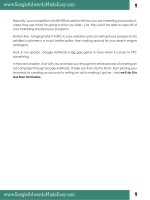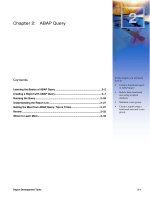SOFTWARE ENGINEERING chapter 2 software+processes
Bạn đang xem bản rút gọn của tài liệu. Xem và tải ngay bản đầy đủ của tài liệu tại đây (25.77 MB, 65 trang )
SOFTWARE
ENGINEERING
Chapter 2 – Software Processes
Jul 2013
Brainstorming...
Chapter 2. Software Processes
2
Jul 2013
Chapter 2. Software Processes
3
RBAC system for Company A.
• - (RQ1) An employee plays 1 or more role(s) according to
•
•
•
•
•
•
her/his job
- (RQ2) System can access the company’s centralized
database
- (RQ3) System to determine whether an employee is
allowed to enter a particular room/hall
- (RQ4) System can control door locking devices
- (RQ5) System to allow 2-3 administrators to edit the
access rights of all employees using Web with good UI.
- (RQ6) System could report arriving/leaving time of an
employee each day
- (RQ7) System will get a signal if locking devices are
tempered with. It may then alert people responsible.
Jul 2013
Chapter 2. Software Processes
4
Processes?
• - Challenge #1
•
•
•
•
•
•
Spec? Design? Coding?
- Challenge #2
Want to test if we can programmatically control the
door-locking devices (e.g., via drivers) before the system
may be built.
Want to build a good GUI for administrators and get
feedback from them
- Challenge #3
How to deal with changes (e.g., upgrading doorlocking devices, adding more features to the admin
function)
Jul 2013
Chapter 2. Software Processes
5
Want to develop the RBAC system?
• Step by step, sequential, will it work?
• An alternative way: let’s iterate
Jul 2013
Chapter 2. Software Processes
How to split the requirements of the
RBAC system into sub-projects
6
Jul 2013
Chapter 2. Software Processes
Theory that follows
7
Jul 2013
Chapter 2. Software Processes
Topics covered
• Software process models
• Process activities
• Coping with change
• The Rational Unified Process
• An example of a modern software process.
8
Jul 2013
Chapter 2. Software Processes
9
The software process
• A structured set of activities required to develop a
software system.
• Many different software processes but all involve:
• Specification – defining what the system should do;
• Design and implementation – defining the organization of the
system and implementing the system;
• Validation – checking that it does what the customer wants;
• Evolution – changing the system in response to changing customer
needs.
• A software process model is an abstract representation of
a process. It presents a description of a process from
some particular perspective.
Jul 2013
Chapter 2. Software Processes
10
Software process descriptions
• Processes:
• about the activities in these processes: specifying a data model,
designing a user interface, etc. and the ordering of these activities.
• Process descriptions may also include:
• Products, which are the outcomes of a process activity;
• Roles, which reflect the responsibilities of the people involved in
the process;
• Pre- and post-conditions, which are statements that are true before
and after a process activity has been enacted or a product
produced.
Jul 2013
Chapter 2. Software Processes
11
Software process models
• The waterfall model
• Plan-driven model. Separate and distinct phases of specification
and development.
• Incremental development
• Specification, development and validation are interleaved. May be
plan-driven or agile.
• Reuse-oriented software engineering
• The system is assembled from existing components. May be plandriven or agile.
• In practice, most large systems are developed using a
process that incorporates elements from all of these
models.
Jul 2013
The waterfall model
Chapter 2. Software Processes
12
Jul 2013
Chapter 2. Software Processes
13
Waterfall model phases
• There are separate identified phases in the waterfall
model:
• Requirements analysis and definition
• System and software design
• Implementation and unit testing
• Integration and system testing
• Operation and maintenance
• The main drawback of the waterfall model is the difficulty
of accommodating change after the process is underway.
In principle, a phase has to be complete before moving
onto the next phase.
Jul 2013
Chapter 2. Software Processes
14
Waterfall model problems
• Inflexible partitioning of the project into distinct stages
makes it difficult to respond to changing customer
requirements.
• Therefore, this model is only appropriate when the requirements
are well-understood and changes will be fairly limited during the
design process.
• Few business systems have stable requirements.
• The waterfall model is mostly used for large systems
engineering projects where a system is developed at
several sites.
• In those circumstances, the plan-driven nature of the waterfall
model helps coordinate the work.
Jul 2013
Chapter 2. Software Processes
Incremental development
15
Jul 2013
16
Chapter 2. Software Processes
Incremental Development
Iteration No.
Test whole
Integrate
Test units
Implement
Design
Analyze
requirements
1
2
3
867
868
Jul 2013
Chapter 2. Software Processes
17
Incremental development benefits
• The cost of accommodating changing customer
requirements is reduced.
• The amount of analysis and documentation that has to be redone is
much less than is required with the waterfall model.
• It is easier to get customer feedback on the development
work that has been done.
• Customers can comment on demonstrations of the software and
see how much has been implemented.
• More rapid delivery and deployment of useful software to
the customer is possible.
• Customers are able to use and gain value from the software earlier
than is possible with a waterfall process.
Jul 2013
Chapter 2. Software Processes
18
Incremental development problems
• The process is not visible.
• Managers need regular deliverables to measure progress. If
systems are developed quickly, it is not cost-effective to produce
documents that reflect every version of the system.
• System structure tends to degrade as new increments are
added.
• Unless time and money is spent on refactoring to improve the
software, regular change tends to corrupt its structure.
Incorporating further software changes becomes increasingly
difficult and costly.
Jul 2013
Chapter 2. Software Processes
19
Reuse-oriented software engineering
• Based on systematic reuse where systems are integrated
from existing components or COTS (Commercial-off-theshelf) systems.
• Process stages
• Component analysis;
• Requirements modification;
• System design with reuse;
• Development and integration.
• Reuse is now the standard approach for building many
types of business system
Jul 2013
Chapter 2. Software Processes
20
Reuse-oriented software engineering
Jul 2013
Chapter 2. Software Processes
21
Types of software component
• Web services that are developed according to service
standards and which are available for remote invocation.
• Collections of objects that are developed as a package to
be integrated with a component framework such as .NET
or J2EE.
• Stand-alone software systems (COTS) that are configured
for use in a particular environment.
Jul 2013
Chapter 2. Software Processes
22
Process activities
• Real software processes are inter-leaved sequences of
technical, collaborative and managerial activities with the
overall goal of specifying, designing, implementing and
testing a software system.
• The four basic process activities of specification,
development, validation and evolution are organized
differently in different development processes. In the
waterfall model, they are organized in sequence, whereas
in incremental development they are inter-leaved.
Jul 2013
Chapter 2. Software Processes
23
Software specification
• The process of establishing what services are required and
the constraints on the system’s operation and development.
• Requirements engineering process
• Feasibility study
• Is it technically and financially feasible to build the system?
• Requirements elicitation and analysis
• What do the system stakeholders require or expect from the system?
• Requirements specification
• Defining the requirements in detail
• Requirements validation
• Checking the validity of the requirements
Jul 2013
Chapter 2. Software Processes
24
The requirements engineering process
Jul 2013
Chapter 2. Software Processes
25
Software design and implementation
• The process of converting the system specification into an
executable system.
• Software design
• Design a software structure that realises the specification;
• Implementation
• Translate this structure into an executable program;
• The activities of design and implementation are closely
related and may be inter-leaved.









